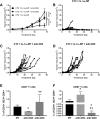Interleukin-1 alpha increases anti-tumor efficacy of cetuximab in head and neck squamous cell carcinoma
- PMID: 30890189
- PMCID: PMC6425573
- DOI: 10.1186/s40425-019-0550-z
Interleukin-1 alpha increases anti-tumor efficacy of cetuximab in head and neck squamous cell carcinoma
Abstract
Background: Despite the high prevalence of epidermal growth factor receptor (EGFR) overexpression in head and neck squamous cell carcinomas (HNSCCs), incorporation of the EGFR inhibitor cetuximab into the clinical management of HNSCC has not led to significant changes in long-term survival outcomes. Therefore, the identification of novel therapeutic approaches to enhance the clinical efficacy of cetuximab could lead to improved long-term survival for HNSCC patients. Our previous work suggests that EGFR inhibition activates the interleukin-1 (IL-1) pathway via tumor release of IL-1 alpha (IL-1α), although the clinical implications of activating this pathway are unclear in the context of cetuximab therapy. Given the role of IL-1 signaling in anti-tumor immune response, we hypothesized that increases in IL-1α levels would enhance tumor response to cetuximab.
Methods: Parental and stable myeloid differentiation primary response gene 88 (MyD88) and IL-1 receptor 1 (IL-1R1) knockdown HNSCC cell lines, an IL-1R antagonist (IL-1RA), neutralizing antibodies to IL-1α and IL-1β, and recombinant IL-1α and IL-1β were used to determine cytokine production (using ELISA) in response to cetuximab in vitro. IL-1 pathway modulation in mouse models was accomplished by administration of IL-1RA, stable overexpression of IL-1α in SQ20B cells, administration of rIL-1α, and administration of a polyanhydride nanoparticle formulation of IL-1α. CD4+ and CD8+ T cell-depleting antibodies were used to understand the contribution of T cell-dependent anti-tumor immune responses. Baseline serum levels of IL-1α were measured using ELISA from HNSCC patients treated with cetuximab-based therapy and analyzed for association with progression free survival (PFS).
Results: Cetuximab induced pro-inflammatory cytokine secretion from HNSCC cells in vitro which was mediated by an IL-1α/IL-1R1/MyD88-dependent signaling pathway. IL-1 signaling blockade did not affect the anti-tumor efficacy of cetuximab, while increased IL-1α expression using polyanhydride nanoparticles in combination with cetuximab safely and effectively induced a T cell-dependent anti-tumor immune response. Detectable baseline serum levels of IL-1α were associated with a favorable PFS in cetuximab-based therapy-treated HNSCC patients compared to HNSCC patients with undetectable levels.
Conclusions: Altogether, these results suggest that IL-1α in combination with cetuximab can induce a T cell-dependent anti-tumor immune response and may represent a novel immunotherapeutic strategy for EGFR-positive HNSCCs.
Keywords: Anakinra; Biomarker; Cetuximab; Cytokines; EGFR; HNSCC; Interleukin-1; Nanoparticle.
Conflict of interest statement
Ethics approval and consent to participate
Not applicable.
Consent for publication
Not applicable.
Competing interests
The authors declare that they have no competing interests.
Publisher’s Note
Springer Nature remains neutral with regard to jurisdictional claims in published maps and institutional affiliations.
Figures







Similar articles
-
Interleukin-1 blockade overcomes erlotinib resistance in head and neck squamous cell carcinoma.Oncotarget. 2016 Nov 15;7(46):76087-76100. doi: 10.18632/oncotarget.12590. Oncotarget. 2016. PMID: 27738319 Free PMC article.
-
Cetuximab therapy in head and neck cancer: immune modulation with interleukin-12 and other natural killer cell-activating cytokines.Surgery. 2012 Sep;152(3):431-40. doi: 10.1016/j.surg.2012.05.035. Epub 2012 Jul 6. Surgery. 2012. PMID: 22770960 Free PMC article.
-
Radiotherapy is enhanced by CPH:SA IL-1α microparticles in a murine HNSCC tumor model.BMC Cancer. 2025 Apr 1;25(1):588. doi: 10.1186/s12885-025-13995-3. BMC Cancer. 2025. PMID: 40169985 Free PMC article.
-
Tumor microenvironmental modification by the current target therapy for head and neck squamous cell carcinoma.J Exp Clin Cancer Res. 2023 May 5;42(1):114. doi: 10.1186/s13046-023-02691-4. J Exp Clin Cancer Res. 2023. PMID: 37143088 Free PMC article. Review.
-
The Right Partner in Crime: Unlocking the Potential of the Anti-EGFR Antibody Cetuximab via Combination With Natural Killer Cell Chartering Immunotherapeutic Strategies.Front Immunol. 2021 Sep 7;12:737311. doi: 10.3389/fimmu.2021.737311. eCollection 2021. Front Immunol. 2021. PMID: 34557197 Free PMC article. Review.
Cited by
-
Oropharyngeal tumor cells induce COX-2 expression in peripheral blood monocytes by secretion of IL-1α.Front Immunol. 2022 Nov 8;13:1011772. doi: 10.3389/fimmu.2022.1011772. eCollection 2022. Front Immunol. 2022. PMID: 36426368 Free PMC article.
-
Alternol triggers immunogenic cell death via reactive oxygen species generation.Oncoimmunology. 2021 Jul 21;10(1):1952539. doi: 10.1080/2162402X.2021.1952539. eCollection 2021. Oncoimmunology. 2021. PMID: 34350063 Free PMC article.
-
Exploration of prognostic biomarkers in head and neck squamous cell carcinoma microenvironment from TCGA database.Ann Transl Med. 2023 Feb 28;11(4):163. doi: 10.21037/atm-22-6481. Ann Transl Med. 2023. PMID: 36923087 Free PMC article.
-
A preliminary analysis of interleukin-1 ligands as potential predictive biomarkers of response to cetuximab.Biomark Res. 2019 Jul 16;7:14. doi: 10.1186/s40364-019-0164-0. eCollection 2019. Biomark Res. 2019. PMID: 31346466 Free PMC article.
-
IL-1α Processing, Signaling and Its Role in Cancer Progression.Cells. 2021 Jan 7;10(1):92. doi: 10.3390/cells10010092. Cells. 2021. PMID: 33430381 Free PMC article. Review.
References
-
- Soulieres D, Senzer NN, Vokes EE, Hidalgo M, Agarwala SS, Siu LL. Multicenter phase II study of erlotinib, an oral epidermal growth factor receptor tyrosine kinase inhibitor, in patients with recurrent or metastatic squamous cell cancer of the head and neck. J Clin Oncol. 2004;22:77–85. doi: 10.1200/JCO.2004.06.075. - DOI - PubMed
Publication types
MeSH terms
Substances
Grants and funding
LinkOut - more resources
Full Text Sources
Medical
Research Materials
Miscellaneous
